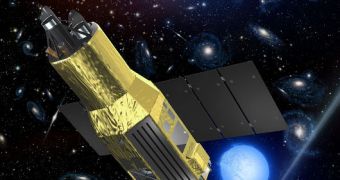The Astro-H X-ray Telescope reached a critical milestone recently, when officials from the European Space Agency (ESA) and the Japan Aerospace Exploration Agency (JAXA) signed a document cementing their collaboration for this project.
The mission is also known as the New X-Ray Telescope, or NeXT. Its main purpose will be to study some of the most extreme phenomena in the Universe, say experts from JAXA. The Japanese came up with the idea for this satellite, and enlisted the help of Europeans to see its development through.
Astro-H is currently expected to launch in Earth's orbit aboard a Japanese-built H-IIA delivery system. Takeoff will occur in 2014, from the Tanegashima Space Center. The spacecraft itself will weigh around 2.4 tons, and will be placed in an orbit around 550 kilometers (341 miles) above the surface.
According to JAXA, this spacecraft will be the heaviest the agency has ever constructed. Its design calls for it to be launched in a folded position, and to be extended in space. When fully deployed, the satellite will be around 14 meters (46 feet) long.
“Astro-H will study astrophysical objects including black holes and neutron stars, explore the non-thermal Universe, and investigate the large-scale structure of the Universe and its evolution,” ESA announces in a new press release.
The same document indicates that the ESA-JAXA agreement was signed on March 16, between ESA Director of Science and Robotic Exploration, professor Alvaro Giménez Cañete, and the Director General of the Japanese Institute of Space and Astronautical Science (ISAS), Dr. Junjiro Onoda.
Under the terms of the arrangement, ESA will be responsible for providing operations and user support for the mission, as well as a series of hardware components. In return, JAXA will allow European scientists access to observation time aboard the spacecraft.
“Astro-H will investigate the physics of the high-energy Universe by performing high-resolution, high-throughput spectroscopy with moderate spatial resolution over the 0.3–600 keV energy range,” ESA says.
Europe and Japan collaborated successfully in the past, in missions pertaining to space sciences, planetary exploration, Earth observation and the International Space Station (ISS) project.

 14 DAY TRIAL //
14 DAY TRIAL //